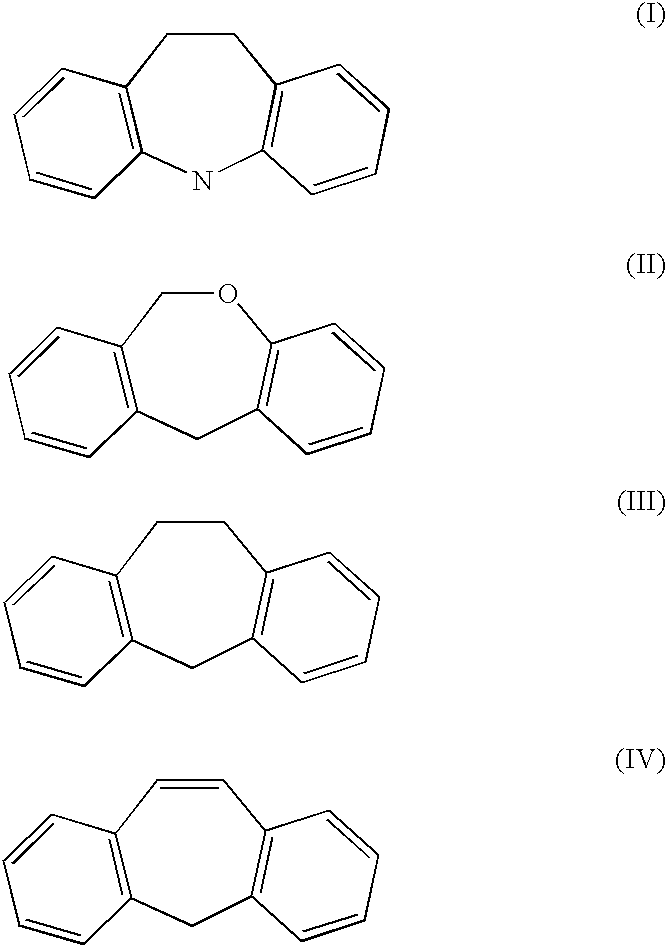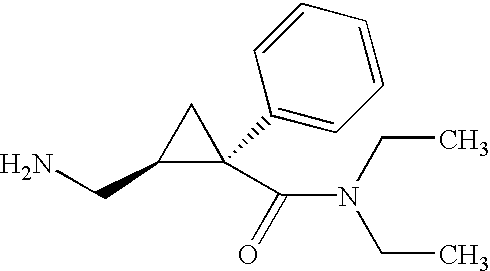Method of treating chronic fatigue syndrome
a technology of chronic fatigue syndrome and fibromyalgia, which is applied in the field of chronic fatigue syndrome and pain treatment, can solve the problems of cfs patients suffering from disordered sleep, localized tenderness, and diffuse pain and fatigue, and no single pharmacological agent or combination of agents is effective in the treatment of either of these disorders, and achieves the effect of reducing the amount of cfs, and reducing the risk of cfs
- Summary
- Abstract
- Description
- Claims
- Application Information
AI Technical Summary
Benefits of technology
Problems solved by technology
Method used
Image
Examples
example 1
5.1 Example 1
Assessment of the Analgesic Properties of Milnacipran in a Rat Pain Model
[0068] The rats used in this study are divided into two groups. One group of rats receive a spinal ligation as described in Kim et al., 1992, Pain 50(3):355-63 and the other group of rats receive a sham surgery. Each group of rats is further divided into 5 subgroups. Each subgroup receives subcutaneous injection of the vehicle or one of the 4 test doses of milnacipran (5, 10, 25, and 50 mg / kg). The vehicle or milnacipran are administered at a pre-determined time point following the surgeries. Allodynia and thermal hyperalgesia are respectively measured with Von Frey filaments and tail- or paw-flick with a radiant heat source. The allodynia and thermal hyperalgesia measurements are performed at the following time points--prior to surgery, following surgery but prior to the administration of vehicle or milnacipran, and following surgery after the administration of vehicle or milnacipran. The allodyni...
example 2
5.2 Example 2
Assessment of the Efficacy of Milnacipran in an FMS Animal Model
[0069] This study is performed on rats or mice that have undergone stress-induced hyperalgesia as described in Quintero et al., 2000, Pharmacology, Biochemistry and Behavior 67:449-458. The study consists of 3 groups: placebo, milnacipran subcutaneous pretreatment, and milnacipran treatment. The milnacipran groups are further divided to 4 subgroups and each subgroup is administered 5, 10, 25, or 50 mg / kg of milnacipran. In the milnacipran subcutaneous pretreatment group, the milnacipran is administered prior to the inducement of the stress-induced hyperalgesia. In the milnacipran treatment group, the milnacipran is administered following the inducement of the stress-induced hyperalgesia. Allodynia and thermal hyperalgesia are respectively measured with Von Frey filaments and tail- or paw-flick with a radiant heat source. The allodynia and thermal hyperalgesia measurements are performed at the following time...
example 3
5.3 Example 3
Assessment of the Efficacy of Milnacipran in FMS Patients
[0070] Approximately 40 subjects are studied for a total of 6 weeks, after being weaned from their previous analgesic or antidepressant medications.
[0071] The inclusion criteria for this study is as follows:
[0072] 1. Patients meet the 1990 American College of Rheumatology criteria for fibromyalgia syndrome.
[0073] 2. Male or female between the ages of 18 and 70 years. Females are either postmenopausal (no menses for at least 1 year) or status-post oophorectomy (bilateral) or have a negative pregnancy test and be using an accepted method of contraception.
[0074] 3. Patients have a Gracely intensity pain scale recording (weekly recall) of at least 10 or more on a 20 point scale at baseline.
[0075] 4. Patients may use non-prescription doses of NSAIDs, aspirin and acetaminophen on a PRN basis for acute pain unrelated to their underlying fibromyalgia.
[0076] The patients are divided into 2 groups. The first group is admini...
PUM
| Property | Measurement | Unit |
|---|---|---|
| structures | aaaaa | aaaaa |
| concentrations | aaaaa | aaaaa |
| equilibrium dissociation constants | aaaaa | aaaaa |
Abstract
Description
Claims
Application Information
 Login to View More
Login to View More - R&D
- Intellectual Property
- Life Sciences
- Materials
- Tech Scout
- Unparalleled Data Quality
- Higher Quality Content
- 60% Fewer Hallucinations
Browse by: Latest US Patents, China's latest patents, Technical Efficacy Thesaurus, Application Domain, Technology Topic, Popular Technical Reports.
© 2025 PatSnap. All rights reserved.Legal|Privacy policy|Modern Slavery Act Transparency Statement|Sitemap|About US| Contact US: help@patsnap.com



